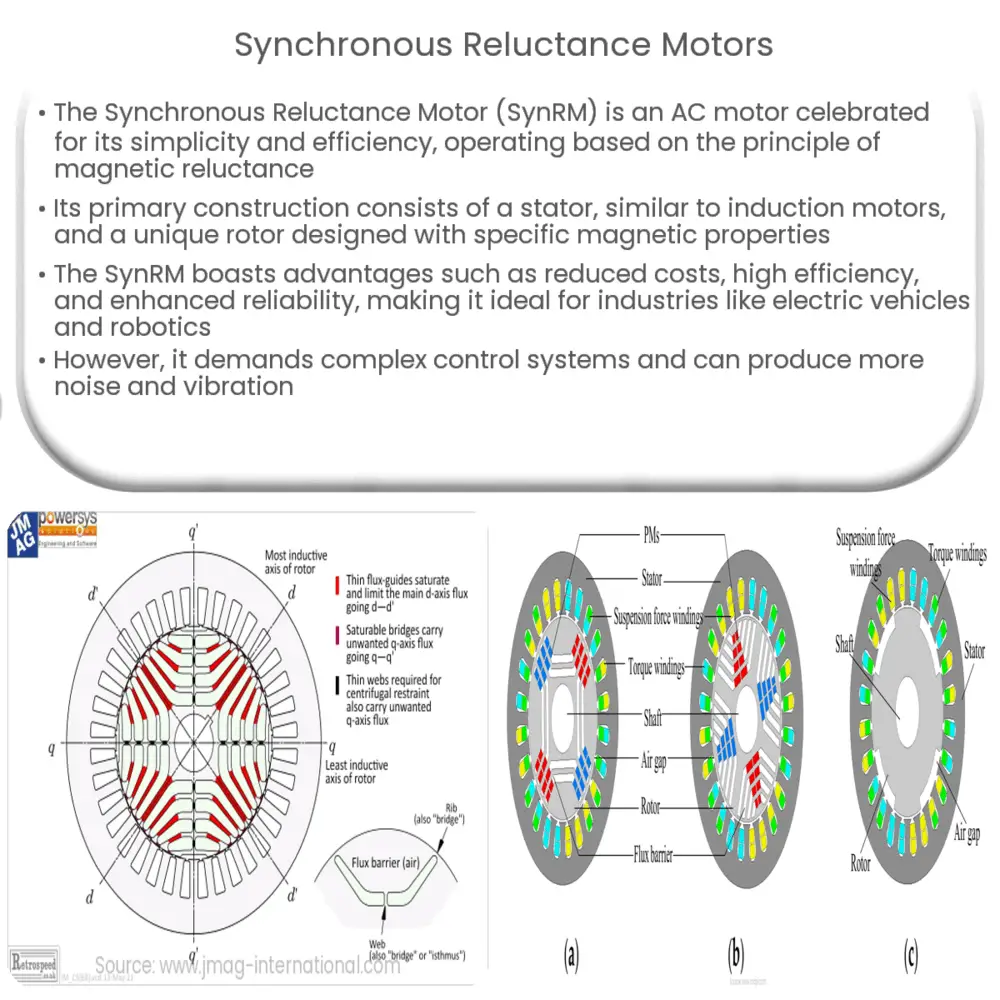Explore the workings, advantages, and applications of Synchronous Reluctance Motors, their modern variants, and future significance.

Synchronous Reluctance Motors: An Overview
The Synchronous Reluctance Motor (SynRM) is a type of alternating current (AC) motor known for its simplicity and high efficiency. It operates based on the principle of reluctance, which is a property of magnetic circuits. The term “synchronous” refers to the motor’s ability to operate at a speed directly proportional to the supplied frequency, keeping its rotation in sync with the frequency of the power supply.
Working Principle of Synchronous Reluctance Motors
The primary principle behind a synchronous reluctance motor is that a magnetic object tends to move from a region of low magnetic permeability to a region of high magnetic permeability. This phenomenon is known as ‘reluctance’. This movement is similar to how an electrical charge moves from high resistance to low resistance in an electrical circuit. In the motor, the rotor is designed to create areas of high and low magnetic permeability, which interact with the magnetic field created by the stator.
Construction of Synchronous Reluctance Motors
Synchronous reluctance motors are composed of two main parts: the stator and the rotor.
- The Stator: The stator of a SynRM is similar to that of an induction motor. It consists of a laminated cylindrical core with uniformly distributed slots. Three-phase windings are inserted into these slots, which, when supplied with three-phase AC, produce a rotating magnetic field.
- The Rotor: The rotor is where synchronous reluctance motors differ significantly from other motor types. Instead of being wound like other motors, the rotor in a SynRM is built with specific magnetic properties, creating regions of high and low magnetic permeability when exposed to the stator’s magnetic field. The rotor’s construction allows it to align with the stator’s rotating magnetic field, driving rotation.
Advantages and Applications of Synchronous Reluctance Motors
Synchronous reluctance motors provide several advantages, making them suitable for various applications. The motor’s simple design reduces manufacturing and maintenance costs. It also operates with a high power factor and efficiency, reducing energy consumption.
Additionally, the lack of rotor current in a SynRM reduces rotor losses and eliminates the risk of rotor bar breakage. This leads to better reliability and extends the overall lifespan of the motor. Moreover, their performance can be easily controlled and optimized using modern electronic controllers.
Applications
Because of these advantages, synchronous reluctance motors find widespread use in industries that demand high efficiency and reliability. This includes industries such as electric vehicles, robotics, and renewable energy, where the efficiency of motor operation plays a crucial role. In these applications, SynRMs provide a combination of high performance, controllability, and robustness.
Modern Advancements and Variations
Over time, variations of the synchronous reluctance motor have been developed to enhance certain aspects of the motor’s performance. For instance, the Permanent Magnet Synchronous Reluctance Motor (PM-SynRM) combines the high efficiency and control of a SynRM with the high torque density of a permanent magnet motor. This variant incorporates permanent magnets into the rotor, enhancing the motor’s overall performance.
Challenges and Limitations
Despite the many benefits of synchronous reluctance motors, they do have some limitations. One of the primary challenges is the complex control needed for their operation. This requires sophisticated drive systems that can significantly increase the motor’s overall cost. Additionally, SynRMs produce more noise and vibration compared to other types of motors due to torque ripple caused by the rotor’s construction.
Conclusion
In conclusion, synchronous reluctance motors stand as a compelling solution in many modern industries due to their high efficiency, low maintenance, and reliability. While there are challenges associated with their implementation, continued advancements in motor design and control systems are making these motors increasingly practical for a wider range of applications. As our world continues to prioritize energy-efficient solutions, the synchronous reluctance motor’s role will undoubtedly become even more significant.

